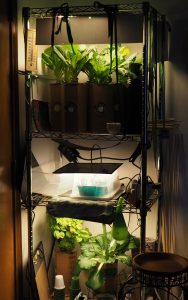In recent years, there have been numerous stories about lettuce being contaminated by (ahem) unhealthy watering practices. “Throw away your Romaine!” has been in the news over and over.
I don’t like being frightened of produce.
Before Romaine, it was spinach. Again and again, spinach contaminated. It actually gave me a distaste for raw spinach – I prefer it cooked, these days.
But I will not give up my Romaine, dammit. I decided to take matters into my own hands.
I now grow my lettuce in the house, year-round, in a low-tech passive hydroponic garden. I’ve been doing this for a year and a half now (or is it two and a half? time is so squishy these days). I haven’t bought any lettuce in many months.
This tower rack sits in the corner of my office (because it’s the coolest room in the house), taking up a 2’x3′ footprint. It’s got lettuces up top, seedlings in the center, and bok choy and basil plants on the bottom. Both of those produce amazing amounts of wonderful leaves. I think they’re both over a year old, now.
I’ve got some more lettuces in my sun room. At the beginning, there were some on a shelf between the kitchen and the living room, but I decided I prefer not to have the bright grow lights so close to the living room (they are a people-friendly spectrum, but they’re pretty bright).
Fresh veggies, especially greens, start to lose nutritional value the moment they’re picked. By growing them at home, I have clean, absolutely fresh greens year-round, with a carbon footprint of…well, probably zero. The lights I use to grow them are LEDs and are powered by our solar system. Might cost a few cents for our community water system to pump water to the house.
The low carbon footprint is important to me, almost as important as the clean food. That Romaine heart that I used to buy for a couple of bucks had to travel from California, and was probably over a week old, maybe a couple of weeks old, by the time I brought it home. And while a couple of bucks seems fairly inexpensive, it’s a lot more than the cost of my lovely home-grown lettuces.
Growing these darlings is a bit different. You don’t wait for the lettuce to get big and then yank it from the garden. Instead, as soon as it’s big enough, you start harvesting the outer leaves. A few at a time, which is why I keep up to a dozen plants going. That’s enough for nice salads for me and the spouse pretty much every day.
The plants get harvested this way for two or three months. When they’re tired, they bolt, and I retire them with thanks and a bit of ceremony. Each plant has probably given as much lettuce as two or three commercial lettuce heads, by then.
It’s a different way of gardening, and a different way of interacting with my food. I’m very aware of the interdependence between me and my plants. I feed them and make sure they have enough light and don’t get too hot, and in return they feed us. Mutual giving.







